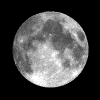| Lunar Eclipses to 2012 |
|---|
| Date |
Type |
Where visible |
|---|
| Aug. 28, 2007 | Total | E. Asia, Australia, Pacific, Americas
|
| Feb. 21, 2008
| Total
| Central Pacific, Americas, Europe, Africa
|
| Aug. 16, 2008
| Partial
| S. America, Europe, Africa
|
| Feb. 9, 2009
| Penumbral
| Europe, Asia, Australia, Pacific, western North America
|
| Jul. 7, 2009
| Penumbral
| Australia, Pacific, Americas
|
| Dec. 31, 2009
| Partial
| Europe, Africa, Asia, Australia
|
| Jun. 26, 2010
| Partial
| E. Asia, Australia, Pacific, western North America
|
| Dec. 21, 2010
| Total
| E. Asia, Australia, Pacific, Americas, Europe
|
| Jun. 15, 2011
| Total
| S. America, Europe, Africa, Asia, Australia
|
| Dec. 10, 2011
| Total
| Europe, E. Africa, Asia, Australia, Pacific, N. America
|
| June 4, 2012
| Partial
| Asia, Australia, Pacific, Americas
|
| Nov. 28, 2012
| Penumbral
| Europe, E. Africa, Asia, Australia, Pacific, N. America
|
- 2004 Moon Phases and 2005 Moon Phases from the Griffiths Observatory.
- Current calendar with moon phases and a list of the year's holidays.
- The phase of the moon for any date from 1800-2199 at any time of the day from any time zone provided by the U.S. Navy.
- The Eclipse Home Page and The Lunar Eclipse Home Page both from NASA. An interesting reference to a past eclipse, on November 9, 2003, shows which parts of Earth see what part of the event.
- How the moon controls tides. I always knew that the moon controlled the tides, but I did not know how. I found out that as the moon rotates around the earth it causes a bulge in the ocean on the side nearest to it. There is a matching bulge on the other side and these bulges move as the moon rotates.
- The orbit of the moon is very nearly circular with only a mean separation of 384,000 kilometers (about 60 earth radii). The moon moves 13.2 degrees every day while the sun only appears to move 1 degree as observed from the earth.
- Names of the phases of the moon. In between the phases of new moon, first quarter, full moon, and last quarter, are the waxing crescent, waxing gibbous, waning gibbous, and waning crescent moons.
- Other things TCC Earth Science 101 students learned:
-
A solar eclipse can only occur during a new moon.
-
A lunar eclipse can only occur during a full moon.
-
"Sideral time," the exact time period from new moon to new moon, is 29.53059 days.
- While the moon orbit is approximately 29.5 days it appears to be 27.3 days on earth because of the movement the earth has made in its orbit during this time.
- The phases of the moon affect tides and fish.
- It is always easier to do your homework the first time than to do a makeup assignment later.
|


